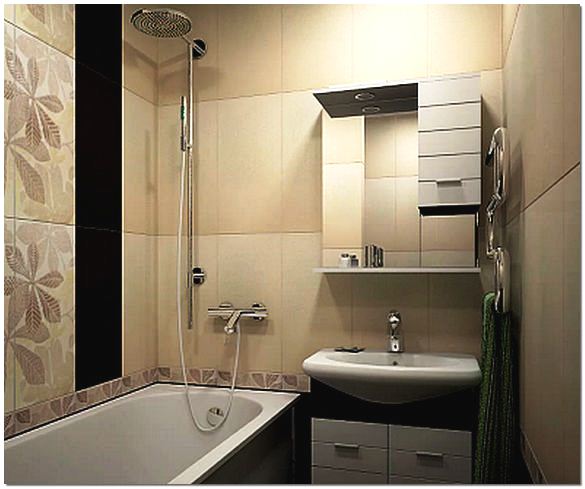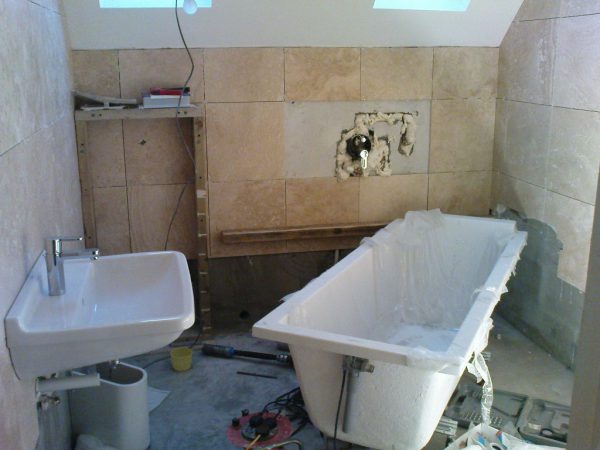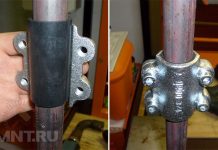The repair procedure depends on the characteristics of the premises and the materials selected. If the walls have been treated with acrylic paint, then plastering can be dispensed with. Before laying the tiles, you will need to make notches on them. Concrete surfaces should be treated with a primer to increase the adhesion of the substrate.
First of all, think about where to start your bathroom renovation. First of all, you need to take into account the state of communication systems. Check pipes, ventilation. In the absence of obvious problems, you can refuse to overhaul communications.
VIDEO
Before starting repairs in the bathroom, you should consider the sequence of work. Without observing the technology, you can ruin the tiles laid out on the floor if you start decorating the walls. You can also damage the tiles on the walls when wiring is required. In order to get a high-quality bathroom renovation, you need to start it right, which can be found in this article.
Of the materials for the initial stage of renovation in the bathroom, you will need:
Mix for mixing concrete.
Waterproofing (roofing material, epoxy or bitumen mastic).
Pipes and hoses for pipeline construction, shut-off valve.
Cables of the required length and cross-section for electrical appliances.
Waterproofing.
The following tools will be used to carry out the work:
Putty knife.
Capacity for mixing the solution.
Scissors.
Rule.
Construction meter.
Pencil.
Brush.
After that, the required materials are calculated. And for this you need to know the size of the room. It is necessary to accurately measure the height and width of the walls, the dimensions of the ceiling and floor. After that, calculate how much tile is required on the walls and floor. You also need to consider whether you need to lay tiles behind the bath. If not, then this area must be subtracted from the calculated one. But do not forget about a small supply of materials (about 10%), which will be spent on cutting. If you decide to lay tiles, read the articles Preparing walls for tiles and How to lay tiles.
It is necessary to calculate the required amount of plaster, which will be required for a possible leveling of the walls. If the surfaces are relatively flat, then much less material will go away.
Preparing a bathroom for renovation consists of several stages:
Overlapping water.
Dismantling of old plumbing, pipes.
Dismantling the door.
Preparation of all surfaces.
The first step is to shut off the water that enters the bathroom. Only then can you dismantle all items from the room. When the room is free of unnecessary items, all surfaces are prepared.
If there are old tiles on the walls and ceiling, then it needs to be knocked down. The coating must also be removed on the painted wall. You can use special quick paint removers. If the old coating is still poorly removed, then shallow notches are made over the entire surface of the walls so that the wall becomes rough.
After carrying out the preparatory work, the following actions are performed:
The floor screed is being made.
Waterproofing is being laid.
A pipeline is being laid.
Power is supplied to the devices.
The floor screed is necessary to facilitate further tiling work. By completing this stage of work, the floor is perfectly flat. In addition to leveling, the screed provides noise and thermal insulation. This is especially important for those who live in a private house and on the ground floors of apartment buildings.
When the screed is dry, it is necessary to lay a layer of waterproofing, which will protect the floor from moisture penetration. Then the pipeline is connected to all plumbing fixtures. Water supply and drainage is provided.
The screed is only done on a clean, dry floor. All debris must be removed from the floor so that no grains of sand remain. After that, the floor is primed with a brush. Then the screed mixture is prepared.
First you need to determine the curvature of the floor. For this, a building level is used. If the floor is flat, no screed is required. When the height difference per 1 m 2 is not more than 1-2 cm, a cement-sand mortar is made. But if the curvature exceeds 2 cm, then a concrete mixture of cement, crushed stone and sand is required.
After preparing the solution, beacons are installed on the floor, along the top of which you can draw a horizontal line. If you put a building level on top of the lighthouses, then it should show a flat surface.
Then the prepared mixture is poured onto the floor in parts. It should reach the top of the beacons, but not completely. An hour later, the lighthouses are pulled out of the dried solution, and therefore it is required that the solution does not completely cover their tops.
The resulting gaps from the lighthouses are filled with a solution. After that, the room is left to dry the floor. During drying, it is better to cover the floor surface with plastic wrap, due to which the concrete will not crack.
After the concrete has dried, it is imperative to make waterproofing. This is extremely important in order to protect the concrete from absorbing excess moisture.
Waterproofing consists of the following stages:
Primers.
Preparation of material for waterproofing.
Application of a solution (or material)
First of all, the floor must be primed. When insulating floors with liquid mixtures, priming will additionally provide better adhesion.
If rolled waterproofing is used, then it is cut into sheets of the required dimensions. After that, it is laid on the floor. The sheets of material should be stacked tightly to each other. Seams should be glued with special tape.
Liquid waterproofing is applied with a brush to the entire surface. And when using pasty compositions, a spatula is used. In the first and second cases, you need to ensure that the material is applied in an even layer.
Installing piping in the bathroom is one of the most challenging tasks. The main thing in this matter is the correct drawing up of communication layouts. It has already been described above how to do this correctly.
After that, the method of laying is determined, which can be:
Open means the passage of pipes along the walls from the outside. This type is less presentable than the closure type of gasket. The last option is good because all pipes are hidden in the walls. But for this you will have to spend a lot of time, because you have to gouge the walls.
So, if an open installation type is chosen, then all pipes are laid along the walls as low as possible to the floor. When closed, it is necessary to draw the places of passage of pipes on the wall, then perform a slitting of the surface. Pipes are laid in the prepared groove, which are covered with cement mortar from above.
When installing the pipeline, it is necessary to consistently connect one of its elements with another. All connections must use a rubber gasket to protect against leaks.
The manifold type of laying implies a separate laying of pipes for each device. Due to this, a shut-off valve can be installed on each site, which will allow to shut off the water not immediately in the whole house, but only in a separate area. After laying the line, you need to check the system for leaks.
When laying electrical wiring in the bathroom, there are several points to consider:
Installation of circuit breakers.
Use of 3-core cables.
Use only protected electrical devices.
First of all, you need to calculate the load of all electrical appliances in the bathroom. To it you need to add about 25% of the stock.After that, the devices must be divided into several groups (the load of a separate group should not exceed 1.5 kW). After that, an automatic switch of the corresponding rating is installed in the electrical panel for each group of consumers.
Use only three-core cables. The 1st core is connected to the phase, the 2nd - to the neutral conductor, the 3rd - to the ground loop on the house. If such a contour is absent in an apartment building, then the core can be brought out to any metal surface, for example, to the shield door.
It is recommended to use electrical devices only with protection. The sockets must be capable of connecting to them grounding, as well as with a protective cover that protects against moisture.
Basic professional tips for initial bathroom renovations:
The first step is to level the floor.
The second stage is the connection of the water supply and electricity.
It is necessary to determine in advance the location of the plumbing, so that you do not have to redo it.
Before making repairs in the bathroom, it is recommended to watch the video instruction, which contains the step-by-step implementation of the rough work in the bathroom.
VIDEO
The initial stage of bathroom renovation is the most difficult and responsible one. Further work and the final result depend on this. Such recommendations will help to complete the rough work as efficiently as possible and help save time and material resources.
Step-by-step instructions for repairing a bathroom and toilet.
According to most finishers, repairs in an apartment should be started from the bathroom. Let me explain why: this is the dirtiest and dustiest part of the renovation, requiring not only the dismantling of old tiles, plumbing fixtures, doors, and sometimes the entire bathroom walls.
So the first thing we do is we take out the old plumbing: a bath, a sink, a toilet bowl ... Everything that costs, weighs, lies .
• Next stage: with the help of a grinder we cut off all the old pipes to the crane located on the riser .
• Using a punch, knock down the old tiles .
It is important if the plaster under the tiles moves away from the wall, bunches ... it must also be beaten off.
• We dismantle the old door together with the box .
• Change risers ... Now we turn our attention to the plumbing and sewer risers. This is a very important part of the renovation and must be changed. After renovation it will be very problematic. If you are not a specialist in plumbing work, then to replace the risers, it is better to invite qualified craftsmen, but you can do the internal wiring of the water supply yourself.
• Checking the hood ... Let's move on to the hood. If we do not want the bathroom to be stuffy, we need to check the operation of the hood. To do this, we bring a burning candle to the hood and evaluate its work by the tongue of the flame: the better the hood works, the more intensely the flame is sucked into the chimney pipe. If the hood does not work correctly, we either clean it or install a fan in it.
• We ground the walls ... At the next stage, I propose to clean up properly: take a broom and sweep out all the debris and dust from the bathroom. After all the dust has settled, we take a deep penetration primer and prime the walls.
• Installing beacons ... After the primer has completely dried, we install beacons for further plastering of the bathroom. Lighthouses must be installed strictly according to the level, observing the plane of the wall and maintaining angles of 90 degrees.
• Plastering walls ... Have you installed the lighthouses? Let's start plastering. To do this, we need a rule, a spatula, a drill and a drill mixer attachment. Bathrooms are plastered, as a rule, with dry gypsum mixtures, since there is no shortage of them on the market. I usually use Rotband plaster. We take a bucket of 12 liters and prepare a solution in it as written in the instructions. Using a spatula, we throw a solution between the beacons of one wall 50 centimeters from the floor. Then we take the rule, press it against the lighthouses and pull it up - we get a flat surface.We remove superfluous from the rule. And so on all the walls - from floor to ceiling. There are not large pits left - it does not matter - then we level them with a spatula. If everything is smooth and beautiful, then you have coped with the task.
• Leveling the floors ... The next stage is the floors. We level them with the help of "self-leveling floors". We dilute the mixture as stated in the instructions, it can even be slightly thinner, and spread it all over the floor using a needle roller. After drying, the walls and floors, just in case, we check by level, we eliminate unevenness.
• We make a detailed plan of the bathroom ... At the next stage, we must decide on the design of the bathroom, where? as? and at what height? there will be a bath, a sink, a mirror, a washing machine (if any), a towel dryer, a toilet bowl, a box covering the risers. To do this, we take a tape measure and measure our bathroom - after plastering, the dimensions have changed. Then we take a pencil and a sheet of paper, and sketch everything. Let's call this a bathroom plan. For the plan to be accurate, at this stage, we need to buy all the bathroom objects. It is important to remember: if the bathtub is tied to the size (I mean that your bathtub is not half a football field, but for example 1m.70cm by 1m.50cm), then the bath should be bought as long as possible. And if your size is 1m.68cm. - you need to buy a bath for 1m.70cm. Then 2cm. screw it up. With this sort of sorted out.
VIDEO
Video - turnkey bath repair
• We make (sketch) a detailed markup of the water supply and sewerage system ... If everything is purchased, then we continue. We collect the bath in a free room. We put it on the legs and level it. As a rule, in most bathtubs, the height of the legs is adjustable - we adjust the height for you. We measure the height and width of the bath. We transfer the dimensions to the bathroom wall. All the same - we do the same with the sink and the washing machine. The next thing we do is mark on the walls how our water supply and sewerage system will go. A bathroom faucet is usually installed in the center 10 cm above the bathtub - this also needs to be sketched on the walls. The distance between the pipes to the bathroom faucet should be 15cm. We mark the water supply for the sink, based on the structural features of the bedside table, and the length of the flexible hoses of the mixer. We mark only one pipe under the washing machine - the cold one. We sketch the sewer pipes at an angle towards the riser (so that there is a drain). If a small slope can be made under the bath and sink, then the outlet under the washing machine should be at a distance of 50 cm. from the floor.
• We make (sketch) a detailed marking of the wiring ... The next thing we do is define the wiring. How many sockets will we have, and where - if there is a washing machine, then next to it. Use an electric shaver - next to the mirror. If you have a backlit mirror, you will need to bring out a wire under it (decide at what height). If there will be a fan, we will bring it out under it too.
• Making strobes ... When we have completely decided and sketched, we take a puncher and chase it according to the plan. Next, we remove and prime the grooves.
• We install water supply and sewerage ... At the next stage, we install the water supply (comb) and sewerage system. Don't forget to install water meters and filters as well. Since our water supply is retracted into the walls, it is better to use polypropylene pipes or metal-plastic pipes.
• We mount a heated towel rail ... At the next stage, we invite the masters or install the heated towel rail ourselves. The pipes are also wall-mounted.
VIDEO
• We mount the box ... So we still have unclosed risers, and we are fixing it. We assemble a box from a metal profile and sew it up with plasterboard. Drywall must be moisture resistant - it is green. Also, do not forget about the technical hatch, it will be needed so that there is access to the taps and the meter. Then we install a perforated corner on the corner of our box and plaster the entire box.
• We prime the walls and floor ... As a result, what we see is a completely plastered bathroom, without visible pipes and wires. Once again, we look at everything in detail for the presence of irregularities. If there are any, we fix it with a spatula and sandpaper.
• We spread the floor ... Now we lay out the floor with tiles. For this we need - a drill, a mixer, a bucket, an ordinary spatula, a notched trowel, a professional tile cutter, crosses (1.5-2mm.).
We lay out the tiles so that all the cut edges are under the bathroom and sink. This way we will only have a whole tile in plain sight. Do not forget to use the level and insert crosses.
• We spread 1 row of wall tiles under the bathroom from the floor ... Then you will need to lay 1 row of wall tiles under the bathroom - for waterproofing. If you are using a small tile, then 30 centimeters from the floor will be sufficient.
• We rub the tiles under the bathroom (wall, floor) .
• Installing the bath ... It's time for the bathroom. We put the bath in, set it strictly in level and in length and in width. We expand the bath.
• We put wall tiles ... We lay out the wall tiles. We start right from the bathtub, from the most prominent corner, and drive in a circle. From the sides of the bath, you need to drill slats so that all the tiles are level. Finish the top, remove the slats and report on the bottom. Let the tiles dry and take out the crosses.
• We rub the seams .
• We mount the ceiling ... Now we need to decide what we are going to do with the ceiling. There are several options: putty and paint, suspended from plastic panels, tensioned. They are all good in their own way, you choose.
• We install the door. It's time to install the missing plumbing - a sink, a washing machine, a toilet bowl, faucets, a bath screen.
It remains to hang the mirror, put the sockets and the bath is ready.
This order of work will prevent you from making the most common mistakes when the quality of the work performed suffers and sometimes leads to rework.
Hello dear readers! Continuing the theme of repair, I will tell you how to start repairing the bathroom and toilet with your own hands. Surely many repairing these premises are faced with such a question.
If you are the owner of an apartment in which the bathroom is located separately from the toilet, I advise you to start repairs with your own hands at home by working out the same color scheme and style. Even if the rooms are divided, it is one whole. The design is chosen the same or similar in the type of finishing materials used and color.
Toilet and bathroom are kind of twins. I advise you to cover the premises with tiles of the same type, but of a different shade. If you use the same finishing technique, you will end up with dissimilar rooms that will create a different mood. If the walls and floor are made in the same color, but with different finishing materials, discomfort will appear due to the contrast between the rooms.
VIDEO
I think now you understand why it is better to use the same tiles and decor for finishing the bath and toilet. This approach will help you save money. After finishing, there will be scraps, which are most likely to find a place in the second room.
A bathroom is a room in which a person is left alone with thoughts and emotions. Here he takes a shower, relaxes, rests after a hard day, gets rid of irritation and fatigue, gets a boost of energy.
The described effect will only bring a comfortable and comfortable bathroom.
Measure the room ... Take a piece of paper, pencil, tape measure and measure the length and height of the walls, the area of the room. Based on the numbers obtained, calculate the amount of materials that will be required to renovate the bathroom.Imagine a new bathroom ... Decide on the color and type of finishing materials, the location of the bath, furniture and accessories.Prepare the room ... Remove old finishes from the walls and ceiling of the bathroom. The work is dusty and dirty, so wear a respirator. You will need a hammer drill, spatula, metal brush and other tools.Primer the walls ... Route electrical wiring and level the ceiling with putty. At this stage, mark the vertical and horizontal lines using a level or plumb line.Replacing the water supply ... A responsible step, I do not advise saving on money. We are talking about replacing the plumbing, risers and sewers in the bathroom.Floor waterproofing ... By making a cement screed, water will not seep to neighbors. Treat the joints between the walls and the floor, the entire area of the bathroom with a special waterproofing solution.For wall and floor decoration ... Try to lay the tiles in the bathroom yourself. If you don't have the skills, ask a tiler for help. Some, for the sake of economy, do not revet the space behind and under the bathroom. Better to cover the planes, and put the bath on the tiles. The screen will help to hide the side and communications.Door installation ... If you are going to replace your bathroom door, do so before installing the tiles.Skirting and ceiling ... At the end, along the perimeter of the ceiling, install a decorative plinth, and paint the ceiling with water-based paint. If this option for finishing the ceiling in the bathroom is not suitable, pay attention to stretch ceilings or structures made of plastic panels. It remains to close the seams.
VIDEO
Following the instructions, you will reach the final stage. At the end, install the sink, hang the mirror and lamp, install the furniture. The end result is a beautiful room.
People find it difficult to renovate a washroom. The toilet is an important part of the home, which I advise you to repair thoroughly and correctly, taking into account all the little things. How to start the painstaking process, I will tell you below.
VIDEO
Having gone the hard way, in the end you will get a result that will delight you with freshness and originality. But the thought that the author of the masterpiece is you yourself will bring more pleasure.
The combined bathroom has advantages and disadvantages. The main disadvantage is that the room is available only to one household. Plus - the ability to expand the area of the bathroom. It is easy to put a washing machine or a wardrobe in the combined bathroom.
In modern apartments, the toilet is separate from the bathroom. At the same time, the premises are characterized by a small area and there are often cases when a few centimeters are not enough to install furniture or other object. To fully consider the issue, consider how to combine a bathroom and toilet.
This kind of repair, in addition to construction work, provides for "paperwork". According to the rules, redevelopment in the apartment is coordinated with the relevant authorities. In this case, changes are made to the housing plan.
When making a preliminary plan, mark the relocation of plumbing, changes to electrical wiring, and changes to the plumbing system. This is an incomplete list of factors that should not be ignored. The work on combining a bathroom is a small technical part of a huge work.
Once you have approved the plan, switch to repairs. It is better if the household members go on a summer vacation for a while. As a result, they will protect themselves from discomfort, and no one will bother you.
Remove the partition between the bathroom and toilet, line up the walls, which are usually extremely crooked.
Redo the pipes. If necessary, change their location so that they do not interfere. The same goes for the heated towel rail.
The next step is to install electrical wiring. Route cables, locate switches and outlets, and install.
Primer the walls and level the floor with a concrete screed. Before laying the floor covering, be it tiles or other finishing material, fill the floor with bitumen. This will reduce the likelihood of neighbors flooding in the event of a leak.
Stretch ceilings are a good option for a combined unit. Only entrust their installation to professionals, since the arrangement of the ceiling involves the use of special equipment and skills.
Decorate the walls and lay the flooring.To visually expand the space of the room, embed a large mirror in each wall. The combined bathroom will turn out beautiful and original.
The final stage of the renovation involves the installation of plumbing, furniture placement, connection of household appliances, installation of bath accessories - hanging soap dishes, hooks.
If you want to achieve results, listen to the recommendations. They will help you complete the repairs quickly and successfully. When the family returns home, the beauty of the combined bathroom will surprise.
I devote the final part of the article to the layout of the bathroom and the subtleties of choosing furniture. If you have finances, organize a separate bathroom in the house, especially if the family is large. As a result, several people will be able to cope with needs at the same time. If you like a combined bathroom, make sure that it has a sliding partition. Use it to divide the room into zones.
The size of the room. To make the toilet convenient and comfortable, allocate a few square meters for the arrangement. No extra space required. Design a bathroom, guided by tastes and preferences, but you should not overdo it with space - 6-10 squares are enough.
Furniture . Before buying furniture, decide what you want to see in the room. Usually this is a set of a sink, a mirror, a pencil case and a floor stand. Sometimes a hanging cabinet is provided. Before buying a bath headset, make sure of the quality. On the surface of the furniture, paint should lie in an even layer.
Fittings. From accessories, choose models equipped with chrome-plated legs, handles and metal hinges. Fittings are also made of plastic, coated with a layer of chrome. Such furniture is not worth buying, since chrome-plated or gilded plastic handles will quickly lose their original appearance.
Sink . Be sure to inspect the sink for chips and damage. Check the integrity of the product by tapping it lightly. Buy a sink that emits a pleasant ringing boldly. A dull sound is a sign of defects.
Bedside tables and wardrobes. When choosing bedside tables and cabinets, be guided by the size of the room, the number of residents and tastes. If there is more than enough space, buy a large set that can fit a hairdryer, curling iron, shampoos and other things. If there are problems with the area, pay attention to a set of pedestals and several hanging boxes.
Shelves and niches. It is not superfluous to equip the bathroom with open or closed niches and shelves. They will help with the storage of bath utensils. Be sure to provide space for clothes and bath towels. A hanger or a set of hooks will help solve the issue.
I hope your day of knowledge was not in vain and you learned a lot of useful information.
The bathroom is one of the special spaces in your apartment and should be treated with special care. After all, it is here that water is often poured in large quantities and often, in this room there are large drops in temperature and humidity. For the correct and rational organization of finishing work, you should firmly know where to start repairs in the bathroom and have an idea of the sequence of repair work.
Renovation work in the bathroom can be:
Unplanned. The need for spontaneous repairs may appear if an unforeseen situation arises (a pipe breakthrough or your neighbors flooded you). If you decide to replace the bathtub, then this may entail sudden repairs (change of sewer pipes, installation of other plumbing fixtures, renovation of tiles, etc.);
Scheduled renovation. In terms of complexity and material costs, the planned repairs can be capital or cosmetic. Of course, cosmetic repairs are cheaper, but such work can only be carried out if there is no fungus and the health of the water supply system, as well as plumbing. Such repairs include the replacement of wall and ceiling coverings, renovation of the floor and faucets.And more serious repairs, even if not entirely overhauled, require thorough preparation and a serious approach.
Making repairs in the bathroom with your own hands, and wondering where to start, you should first of all decide on the future design of this room. Imagine how you would like to see your bathroom, decide on the color. Traditional colors for this room are pastel colors or a combination of two colors (for example, blue and blue, or peach and beige).
Then you need to decide what materials will be used for finishing. For finishing the bathroom, they often use:
Tiled tiles;
Porcelain stoneware;
Mosaic;
Plastic panels.
Thoroughly inspect your plumbing and, if necessary, decide on the option to replace outdated plumbing fixtures.
Using a tape measure, measure the height, width and length of the room, calculate its area. Determine where the plumbing fixtures will be located, because it is unlikely that it will be possible to change anything after the repair.
VIDEO
Having decided to independently carry out repair work in their bathroom, many owners think about where to start repairs in the bathroom and go to choose new plumbing fixtures and finishing materials. Of course, this stage of repair is very important, but it should be followed only after you have completely decided on the design, the type of new plumbing and the amount of necessary finishing materials.
Before buying plumbing fixtures, be sure to check their dimensions and check if they fit your bathroom.
It is better to purchase finishing materials and tools in one store, where you will also be offered a good discount for a wholesale purchase. Buy everything you need in full at once, so that later you do not waste time and do not run in search of missing material.
Next, you should prepare the room directly for renovation work. It is better to dismantle the sink and bathtub during the repair, even if you do not intend to change them.
Having dismantled the old coating, you can start replacing the pipes. In old houses, in addition to the pipes located directly in the bathroom, it is worth changing the main riser (in the case of a combined bathroom); and in some cases even water pipes between floors. Since old pipes can leak, which is fraught with new unplanned repairs and new costs.
At this stage of the repair work, it is worth replacing the electrical wiring. Determine where the electrical appliances will be located, and bring in the required number of outlets, change the wire and switch.
Do not forget to take care of the repair and installation of ventilation, this is very important for the bath. It is best if ventilation is forced. There are many options on the market today for various forced ventilation fans.
The scale and nature of these works depends on the condition of the surfaces. If the walls are very uneven, then you will have to deal with leveling them with plaster. With fairly even walls and ceilings, there is no need to use a large layer of material, and in some cases, puttying can be dispensed with. If the surface needs to be leveled a lot, then the repair may be delayed.
Now you can start finishing the walls and ceiling: painting, laying tiles, covering with the selected mixtures, etc.
Coating the ceiling with emulsion paint can be an excellent option: the ceiling looks very nice, moisture does not accumulate on it, and you can choose any shade. A more practical alternative would be to install plastic panels or stretch ceilings.
If you will install a bathtub covered with a screen, then you can not lay the floor under it with tiles in order to save material.
Plumbing fixtures are installed after all finishing work is completed, so as not to damage the new (old) plumbing during the repair process and to provide unhindered access to the surfaces of the room that require finishing.
At the final stage of the renovation, furniture and accessories (hooks, mirrors, lamps, etc.) are placed in the bathroom. Also, the door is being replaced only now. It is not worth changing the doors earlier: they can be easily damaged during the repair process, bringing in and installing plumbing.
Now you know where to start renovating the bathroom, and in what sequence to carry out the work. Therefore, you can easily cope with this difficult task, and the updated bathroom will delight you with its brilliance and impeccable appearance.
Video (click to play).
VIDEO












